Geranium garden height. Numerous species and varieties of garden pelargonium.
Garden geranium is a welcome guest in many summer cottages. This wonderful flower, before the breeders worked with it, was a modest meadow plant with a unique flavor and medicinal properties. English and Dutch flower growers managed to bring out the most variety of varieties, beautiful and original, thanks to which garden geranium has become an obligatory participant in landscape compositions.
If we add that, apart from watering, she practically does not need any care, it becomes clear why both experienced gardeners and inexperienced beginners love her so much. It blooms for a very long time, is resistant to drought and frost, and with its specific smell, geranium repels pests both from itself and from neighboring plants.
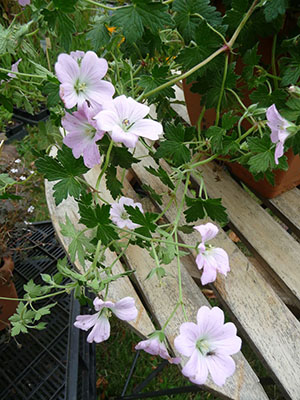 Among the three hundred varieties there are different geraniums: tall and miniature, in the form of a compact bush and growing on the surface, with simple flowers and terry. Each of them is attractive and interesting in its own way.
Among the three hundred varieties there are different geraniums: tall and miniature, in the form of a compact bush and growing on the surface, with simple flowers and terry. Each of them is attractive and interesting in its own way.
 There are only two ways of reproduction: seeds and division of the bush. The first is rarely used because of its complexity. In addition, it is not always possible to preserve varietal characteristics. Seeds are usually collected in order to prevent "unauthorized" resettlement of geraniums throughout the site.
There are only two ways of reproduction: seeds and division of the bush. The first is rarely used because of its complexity. In addition, it is not always possible to preserve varietal characteristics. Seeds are usually collected in order to prevent "unauthorized" resettlement of geraniums throughout the site.
The vegetative method is much simpler, faster and more effective. Having dug up a bush, a part of it is separated or a rhizome is cut and planted in a prepared place. If planting material is purchased at a flower shop, then this is done in February and you need to choose a solid rhizome with a large number of adventitious roots and a live growth point. At home, it must be placed in moistened peat and stored in a refrigerator at a temperature of + 2 ° C until the earth in the flower bed warms up. Every two weeks, peat must be moistened.
If the rudiments of leaves are already visible on the purchased plant, then the growing season has already begun and such a rhizome is temporarily planted in a container of suitable size with drainage holes. All roots should fit in it without bends. Planted geraniums are watered and kept in a bright but cool place. In May, it can be planted in a flower bed, protecting the first time from possible frosts.
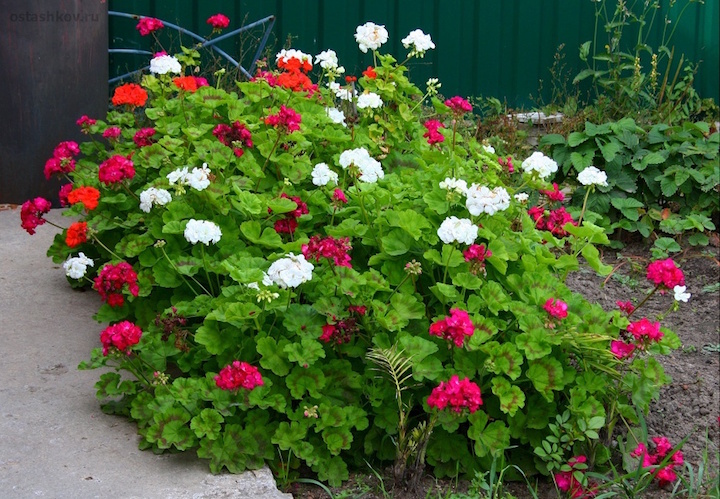 Geraniums need weeding, always in the spring, when the plant has not thrown out a large number of leaves
Geraniums need weeding, always in the spring, when the plant has not thrown out a large number of leaves Geranium does not like transplants and grows quietly in one place for 8-10 years, therefore, immediately upon planting, it creates conditions that will allow it to fully develop all these years. Suitable sunny plot with fertile loose soil, slightly acidic or neutral.
Varieties that will actively grow in width are planted at intervals of 25-30 cm; vacancies are already next year will be completely populated with geraniums. For varieties that form a compact bush, when planting, a distance equal to twice the length of the cutting is measured. Subject to this condition, geranium will always delight with a beautiful spherical shape.
The depth of the landing pit is made by 20 cm more length roots. Fertile soil is poured into the holes in a hill, the roots are carefully distributed over its surface, then the soil is added and the plant is watered. The only requirement is not to make unripe manure when planting.
Propagation of geraniums by cuttings in the photo
How to care for garden geraniums?
This flower is distinguished by its high vitality and absolute unpretentiousness. If properly planted, then he will take care of himself on his own. Weeding will only be needed at first, until the geranium grows. Its leaves are so tightly closed with each other that the weeds have no chance to break through such protection, and if free plots of land are mulched, loosening will not be needed.
Geranium hides even faded inflorescences under its leaves so well that it is not necessary to remove them, the bushes will always have a well-groomed appearance. In autumn, geraniums also do not lose their attractiveness: many varieties are winter-green and go into winter without pruning and without shelter.
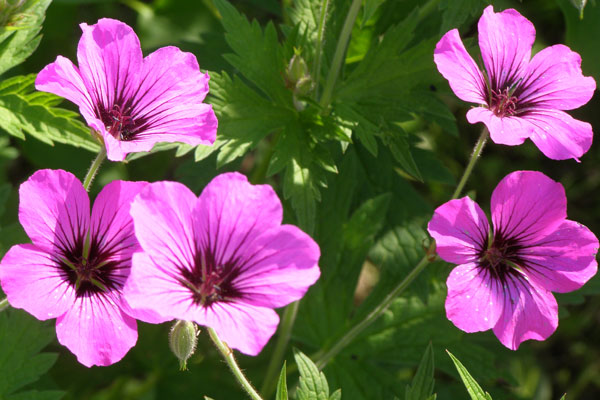 The only thing left for the owner is watering: regular and in moderation, rejuvenation of the bush every 8-10 years and top dressing: spring, when nitrogen fertilizer is applied, and a month later, complex fertilizer is used. They rejuvenate the plant by digging it up before the bush begins to bloom and removing old rhizomes. The bush should have only roots with young developed buds. Then the geranium is planted in a new hole.
The only thing left for the owner is watering: regular and in moderation, rejuvenation of the bush every 8-10 years and top dressing: spring, when nitrogen fertilizer is applied, and a month later, complex fertilizer is used. They rejuvenate the plant by digging it up before the bush begins to bloom and removing old rhizomes. The bush should have only roots with young developed buds. Then the geranium is planted in a new hole.
The varietal variety of geranium provides her universal application in landscape design: it is good in single plantings, organically merges into group compositions, is appropriate in mixborders and rockeries. This is a great chance to decorate your summer cottage, spending a minimum of effort on planting care.
For most inhabitants, geranium is indoor flower, while few people know that there is a garden geranium that grows well on open ground. Moreover, there are several hundred varieties of this plant, some of them are adapted to our climate. Next, we will get acquainted with the features of garden geraniums and some varieties that are most often grown by summer residents and gardeners.
Description of garden geranium
It is believed that England is the birthplace of garden geraniums, which is not surprising, since it is the UK that is the trendsetter in garden landscape art. And geranium has all the necessary qualities for the formation of landscape design.
I must say that the plant is valued not so much for a beautiful flower, but for an attractive habit. Dense and at the same time compact bushes have beautiful and delicate leaves. Moreover, the plant retains its decorative effect until the very winter.
Flowers and leaves may be different sizes and color. In the color palette, the plant is missing only orange and yellow.
It is best to grow the crop in loose, fertile soil. Moreover, landing is desirable to carry out in well-lit open areas.
Note!
Due to the plant's ability to self-propagate and "spread" around the site, geraniums in the garden can become a real weed.
This is especially true for not the most beautiful and desirable species, such as Robert's geranium.
Types of garden geraniums
Although climatic conditions southern part of Britain are significantly different from ours, as mentioned above, some varieties of garden geraniums are perfectly adapted to grow in conditions middle lane. In particular, they tolerate frost well.
These varieties include:
| Geranium blood red | It is a tall variety. The plant forms a beautiful spherical bush. The leaves are bright green, turning reddish in autumn. Flowering begins in June and continues until the very end of August. Thus, the blood-red geranium blooms all summer long. |
| Balkan | It has a thick rhizome that grows rapidly. As a result, the plant can form a thick "carpet". Flowers have a bright purple color, up to 30 mm in diameter. Flowering begins in June and continues for 30 days. A special feature is the strong pleasant aroma of the flower. |
| Red-brown | This garden perennial geranium is a tall variety. It can grow not only in sunny, but also in shaded areas. Flowers small size, dark red. Flowering begins in June and lasts for 40-45 days. |
| Himalayan | Terry variety, whose flowering begins in early June and ends in 30-45 days. The disadvantage is the tendency to be damaged by pests, therefore, it needs preventive treatment with special preparations. |
| eriantum | It has good frost resistance, so flowers can be planted even in the northern regions. |
We have given the most common varieties of perennial garden geraniums, however, there are some other types of this crop that can also grow in our climate, for example:
- Geranium Renard;
- Dalmatian;
- "Album";
- Rose Queen etc.
The choice should be made based on your own preferences and characteristics of the varieties.
Care and cultivation
reproduction
Planting and caring for garden geraniums is not difficult and does not take much time.
Reproduction can be carried out in two ways:
- By dividing the root- perfectly takes root in a new place and quickly takes on new roots. That's why this way simplest.
- Growing from seeds- a more time-consuming method, however, the price of seeds is much lower than the cost of seedlings. Seedlings, as a rule, bloom in the second year after planting.
Those types of geraniums that grow strongly in width must be planted at a distance of 25-30 cm. Already a year after planting, the bushes will close, forming a "solid carpet". Species that form a compact bush with large leaves, should be planted at a distance equal to twice the length of the cutting.
In this case, the beautiful spherical shape will not be violated. After all, it is she who is the highlight of the plant, giving it a special appeal.
I must say that in one place without a transplant, a culture can grow up to 8 or even 10 years. After this, rejuvenation of the bush may be required.
Red-brown geranium
Care
Garden geraniums do not need special care. In particular, there is no need to perform cropping. Faded inflorescences can be removed, however, this procedure is not necessary, as they themselves fall and hide under the leaves.
Due to the fact that the branches of the culture are tightly closed, weeds practically do not grow under them, respectively, the flowers do not need to be weeded with their own hands.
Advice!
If the free areas between the geraniums are mulched or planted undersized plants, the need for loosening will also disappear.
It should be noted that most varieties of geraniums have very useful property- emit a pleasant specific smell around them, which is saturated with phytoncides and essential oils. This protects not only the flowers themselves from diseases, but also their neighbors.
The varieties of crops listed above do not require shelter for the winter, as they can easily tolerate even severe frosts in the open field. As a result, all the care and cultivation of garden geraniums comes down to timely watering.
In the photo - an arch of geraniums
Garden geranium in landscape design
Geraniums are easy to find a place in any garden or on suburban area. Most often, flowers in landscape design are used as follows:
- Dwarf varieties - great for forming flower borders, rose borders or mixborders.
- Large-rhizome varieties - are excellent ground cover plants that allow you to achieve the effect of a "green carpet".
- Spherical varieties - look great in the foreground in mixborders. It can also be used in joint plantings next to shrubs. For example, they look great among ferns, clarets, aquilegia, etc.
- Tall varieties - most often used in mixed mixborders among other perennials. With their help, you can create "wild" areas in a landscape style. In this case, in the foreground it is better to use unpretentious ground covers, which include creeping tenacious, coined loosestrife, etc.
Of course, these are just guidelines for using these colors. You can come up with your own options for landscape design using geraniums. Here, perhaps, are all the features of garden geraniums that can be grown in our area.
Conclusion
As we found out, garden geranium is a very beautiful and at the same time unpretentious plant to care for. Therefore, these flowers are an excellent choice for summer residents and gardeners who want to concentrate on growing other crops.
From the video in this article, you can get some additional information on this topic.
If a geranium already in the garden or on the street is planted, you can divide the bush and plant its parts in early autumn. When a rhizome with rudimentary buds has to be bought and there is no way to plant geraniums in the ground before the onset of cold weather, it is important to keep the rhizome dense and viable.
It is important to remember that perennial outdoor geraniums have well-developed peripheral roots. At planting material this part of the root system must be preserved until planting, and later provide the plant with nutrition and moisture.
To do this, the rhizome is poured and placed in a container or perforated bag. In this form, the future geranium for the garden should be at 1-4 ° C until planting. The peat substrate should be slightly moistened, making sure that the roots do not dry out or rot. The container is chosen so that the roots are completely covered with soil and not intertwined.
 If the plant, even in a basement or refrigerator, started to grow, it should be transferred to a bright, cool room. Here is a long-term garden geranium waiting for planting in deep containers and light nutrient soil and the usual care, which involves moistening the substrate.
If the plant, even in a basement or refrigerator, started to grow, it should be transferred to a bright, cool room. Here is a long-term garden geranium waiting for planting in deep containers and light nutrient soil and the usual care, which involves moistening the substrate.
The easiest and most reliable option when planting and caring for perennial garden geraniums is to purchase planting material with a closed root system. Such seedlings take root easily and can be transferred to the ground in almost any warm season.
When can geraniums be planted outside? Plants do not suffer much from frost, and most species quickly start growing in a new place. Therefore, when the soil warms up to 15–18 ° C, rhizomes can be transplanted into open ground. Depending on the region and weather conditions most often this time comes in the first half of May. If there is a threat of night frosts, unrooted geraniums in the garden are best covered with non-woven material.
Planting geraniums in the garden and caring for the crop
 Existing today ornamental varieties flower growers owe garden geraniums to the interest in this plant of breeders from Holland and Great Britain. While these cultivated species have become brighter, their flowering is more abundant and longer, geraniums in the garden require the selection of conditions close to those in which their wild ancestors grew.
Existing today ornamental varieties flower growers owe garden geraniums to the interest in this plant of breeders from Holland and Great Britain. While these cultivated species have become brighter, their flowering is more abundant and longer, geraniums in the garden require the selection of conditions close to those in which their wild ancestors grew.
When geraniums are planted in open ground in spring, the place for planting is chosen depending on the variety and type:
- Meadow, Himalayan or gorgeous geranium outdoors will actively grow and bloom if the plants are in the sun and they are provided with abundant watering.
- In the dry corners of the garden, where there is a lot of sun, the large-flowered and red-brown variety is indispensable.
- Georgian geranium looks good.
- If there is a wet corner in the shade of trees in the summer cottage, marsh geraniums will grow beautifully here.
- Balkan geranium, when planting and leaving in the country, planting easily tolerates drought and shading.
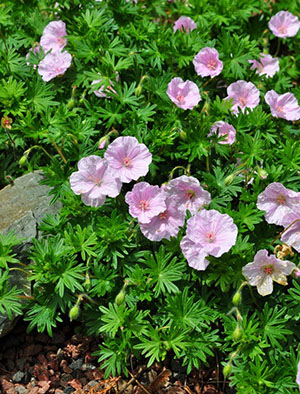 All geraniums have branched long roots that are extremely difficult to transplant. To reduce the stress of this procedure and simplify subsequent care, a rather deep planting of geraniums in the garden is made. landing pit. Its depth should be several centimeters greater than the length of the straightened nutrient soil at the bottom of the root pit. After careful backfilling, the landing site is watered, and the soil is mulched from above.
All geraniums have branched long roots that are extremely difficult to transplant. To reduce the stress of this procedure and simplify subsequent care, a rather deep planting of geraniums in the garden is made. landing pit. Its depth should be several centimeters greater than the length of the straightened nutrient soil at the bottom of the root pit. After careful backfilling, the landing site is watered, and the soil is mulched from above.
Since most species grow significantly in a couple of years, there should be at least 20-30 cm between individual geraniums in the garden.
Due to the density of the crown and the emitted essential oils, weeds are reluctant to settle next to the geraniums, and not all pests can harm the ornamental culture.
And yet, even such an unpretentious plant that can stand up for itself needs support. Geranium care in the garden after planting consists of:
- in regular watering that meets the needs of a particular type of plant;
- in dressings, the first of which, with the help of infusion of compost and peat, is carried out immediately after transplantation;
- in autumn pruning withered leaves and summer retreat withered inflorescences.
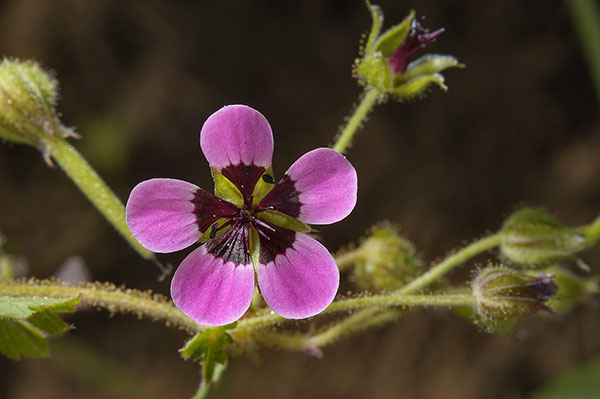 Spring for geraniums should begin with top dressing nitrogen fertilizer. It will push the plant to the formation of lush foliage, and a month later, a complex agent is introduced under the plants, which contains nitrogen, phosphorus, potassium and trace elements. Species accustomed to living in mountains or dry areas need less fertilizer than lowland varieties.
Spring for geraniums should begin with top dressing nitrogen fertilizer. It will push the plant to the formation of lush foliage, and a month later, a complex agent is introduced under the plants, which contains nitrogen, phosphorus, potassium and trace elements. Species accustomed to living in mountains or dry areas need less fertilizer than lowland varieties.
Perennial garden geraniums are an unusual, undemanding and very attractive green decoration for any site. The plant is versatile and can be successfully used in single and group plantings, without requiring special care.
Geranium in the garden and vegetable garden - video
In the view of most inhabitants, the plant, although beautiful, is exclusively indoor. Few people know that garden geranium, unlike its room relative, grows very well in open ground. Moreover, there are more than three hundred varieties of this plant in the world. England is considered the birthplace of garden geraniums, where it is very popular. Of course, the Russian climate is somewhat different from the British one, but there are varieties of garden geraniums that feel good in our open spaces.
Garden geranium - care and cultivation
How to grow geraniums in the garden? Our tips will help you with this:
- Perennial garden geranium is a very unpretentious plant in planting and care. The soil for garden geraniums needs loose and fertile, and it is better to plant it in open, well-lit areas.
- When marking out a site for planting, it should be remembered that due to short rhizomes, geranium grows very strongly in breadth. Therefore, the distance between the bushes should be at least 25-30 cm. In a year, the geranium bushes will grow so much that they form a continuous carpet. In addition, garden geraniums really do not like to transplant, and large distances between bushes will allow her long time grow in one place without a transplant.
- Garden geranium can grow in one place without transplantation and rejuvenation for 10 years.
- Weeding a site planted with geraniums is not necessary, because its densely growing lower leaves no weed will be allowed to grow. If you plant row-spacings with low garden crops or them, then you won’t have to loosen the soil. Thus, caring for geraniums in the garden comes down to timely watering.
- Garden geranium is practically not affected by diseases, and its sharp aroma repels insect pests.
- Perennial garden geranium does not require shelter for the winter and tolerates frost well in open ground.
Propagation of garden geraniums
There are several ways to propagate garden geraniums: rhizome segments or seeds. Propagation of garden geraniums by seeds is a very troublesome task. Firstly, after ripening, the seeds scatter in different directions and it is problematic to collect them. Secondly, with this method of reproduction, varietal characteristics are very often lost. Therefore, most often, garden geraniums are propagated by segments of rhizomes. For this in early spring choose healthy young rhizomes, which are separated from the mother bush, and then planted in the soil and watered.
Garden geranium - varieties
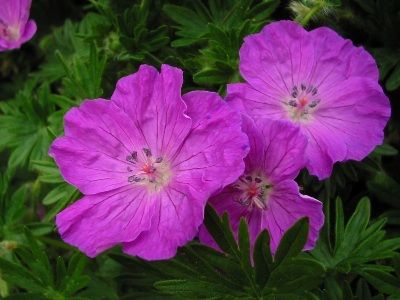
to see a healthy plant at home, you need to apply the secrets of the content. Gardeners love unusual flowers. The subtleties of care for most classes of plants are the same. In this collection, we intended to present a collection of tips to prevent death when growing a particular plant. Any flowering creature requires an individual fulfillment of conditions. It is important to understand for useful actions which family the purchased plant belongs to.
Numerous species and varieties of garden pelargonium
PELARGONIUM (Pelargonium) is indispensable in floral arrangement- differs in plentiful and long blossoming, effective inflorescences, beautiful leaves and is appreciated for unpretentiousness. This plant is usually called geranium, although the correct name is Pelargonium zonale, or hybrid garden. It is a perennial plant grown in gardens as an annual. A number of species are suitable for cultivation in room conditions(see on a separate page)...
), in which the flowers are absolutely regular, the flowers of pelargonium are bilaterally symmetrical. The fruit - a long narrow box, thinning towards the top - resembles the shape of a stork's beak, hence the name of the genus (from the Greek pelargos - stork).
Many species are widespread ornamental plants and are represented in the collections of botanical gardens; some are valuable raw materials for the extraction of essential oil, used in the perfume and soap industries. A number of species are suitable for growing indoors. Grown in gardens, greenhouses, boxes, on balconies.
Zonal group of garden pelargoniums
Pelargonium large-flowered hybrid (P. grandifiorum hybridum hort. (P. domesticam Bailey, P. grandiflorum hort.)). This species is also called English. In England, she is known as a royal or exhibition, and in the US - as "Lady Washington". Pelargonium home, or royal - the closest relative zonal pelargonium. This beauty forms a bush with stiff shoots 30-60 cm high, serrated leaves and large two-tone corrugated flowers with a diameter of 3.5-5 cm, usually white, pink or red. It is not for nothing that this plant is called royal - it is undoubtedly very beautiful, but at the same time it is very demanding on heat. In the garden, it can only be grown in a very warm, protected place, and even better - indoors. Some of the varieties:
 Pelargonium zonal garden (P. zonale hort.). Plants with thick shoots, woody with age, especially below. The leaves are rounded to kidney-shaped, slightly lobed along the edges, pubescent, with a more or less prominent reddish or pale yellow rim. The flowers are collected in umbrellas, red, pink, white, sometimes lilac, simple, semi-double and double. In ornamental horticulture, the species is represented by numerous hybrids and varieties and is used in flower decoration. From P. zonale hort. The following are widely used:
Pelargonium zonal garden (P. zonale hort.). Plants with thick shoots, woody with age, especially below. The leaves are rounded to kidney-shaped, slightly lobed along the edges, pubescent, with a more or less prominent reddish or pale yellow rim. The flowers are collected in umbrellas, red, pink, white, sometimes lilac, simple, semi-double and double. In ornamental horticulture, the species is represented by numerous hybrids and varieties and is used in flower decoration. From P. zonale hort. The following are widely used:
Pelargonium thyroid garden (P. peltatum hort.) Herbaceous plant with long (up to 80 cm) creeping shoots. Leaves 5-8 cm in diameter, thick, smooth, glossy, sometimes finely pubescent, almost round, 5-lobed or 5-angled, entire, more or less ciliated, green, sometimes with a brown zone. Flowers on short peduncles, simple, semi-double and double, red, lilac, pink, white. It is widely used for decoration of balconies and as a pot-and-ampel plant. Common varieties:
Pelargonium garden (Pelargonium hortorum) A cultural species obtained as a result of a series of crosses. It is distinguished by a red or brown border along the edge of the leaves. The flowers are simple or double, white, pink, sometimes variegated, collected in umbellate inflorescences. Varieties of garden pelargonium:
Pelargonium fragrant, or odorous (Pelargonium graveolens) This species is valued for leaves that smell like roses, lemons or apples, and was once popular. Semi-shrub up to 1 m high, with densely branched, pubescent shoots. Leaves 5-7-lobed, pubescent, with a strong aroma. The flowers are medium-sized, pink, collected in umbrella inflorescences.
Pelargonium curly (Pelargonium crispum ‘Variegatum’) The species is valued for its decorative fragrant, yellow-spotted leaves with scalloped or curly edges.
Garden Pelargonium Care Tips
Growing pelargonium is relatively simple, as it is not capricious and is not very susceptible to pests and diseases. But not every gardener manages to achieve abundant flowering. However, this success is the result of diligent and skillful care. Proper Care primarily consists in regular and abundant watering with soft (settled) water, as well as top dressing flower fertilizer with high phosphorus content. For abundant flowering, the timely removal of fading flowers is also important. With such sanitary cleaning, the flowers are removed along with the peduncle. After each shower or wind, the plant is inspected and all damaged areas are removed - flowers, leaves, shoots.
Very photophilous, prefers direct sunlight - their flowering depends on it. In this case, the flowering period is somewhat reduced in plants, but the color of the flowers is brighter. Although Pelargonium can grow and bloom in light partial shade, the color of the corollas becomes less bright, and the stems are stretched. The height and shape of the bush can be adjusted by pruning, using remote shoots on cuttings.
At home, pelargonium grows like a perennial, develops a powerful root system, tolerates winter well, and with the onset of spring, green foliage appears again. In our country, pelargonium cannot winter because of the harsh winter, so in the fall, before the onset of frost, the plant is dug up, the roots are shortened with pruners, and then carefully placed in a pot, at the bottom of which drainage is made.
During the dormant period, in winter, when the plants do not bloom, the substrate in the vessels is kept slightly moist, preventing it from drying out and waterlogging. Plants that have overwintered in the house are planted in the garden when there is no threat of frost and the air warms up to 12-14 degrees. When planting in summer in open ground for pelargonium, a site with good drainage and loose soils is selected. After planting, the soil is watered abundantly and the top layer is mulched from drying out. For better survival, it is desirable to remove the inflorescences.
The main method of reproduction is green cuttings, which are prepared from the tops of growth and side shoots, leaving 3-4 developed internodes. The cuttings are cut with a sharp knife 0.5 cm below the leaf node, the cut is made slightly beveled. The lower leaves that may be in the substrate are cut off.
Before planting, the pelargonium cuttings are slightly dried for a day and placed in a glass of water, and when the roots appear, they are planted in loose soil. You can plant a cutting for rooting immediately in a special substrate. Planted to a depth of 3 cm in a richly watered substrate. The substrate is prepared two-layer. The bottom layer is an equal amount of sand and soddy soil, and the top layer is pure washed sand. When rooting, the cuttings may die from excessive waterlogging. The beginning of rooting occurs on the 15-17th day, and mass - on the 25th. Optimum temperature when rooting - 15-20 degrees and good lighting.
To obtain compact plants in spring, they are formed by removing the top above the 8-10th node. This causes the development of second-order shoots. Be sure to remove wilted leaves from plants so that gray rot does not appear on them.
Hybrids of the first generation (F1) are propagated by seeds. They take a bowl with loose fertile soil and sow seeds in it to a depth of 1.5 cm. Before emergence, the container is kept in a warm place - 20-23 degrees, and then transferred to a cooler place. If you sow seeds in January-February, in July the plants will bloom, throwing out 2-3 peduncles at the same time.
Having several flowering pelargonium bushes in the garden, you can create your own healing corner. She can soothe nervous system, normalize sleep, relieve fatigue. If pelargonium grows in the garden, then there will be no aphids on gladioli, asters and other flower plants. Dried leaves of fragrant geranium are placed in a cabinet against moths.
garden plantsgarden geranium
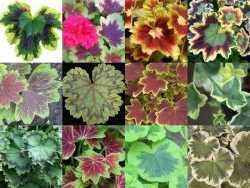
In the view of most inhabitants, geranium is a plant, although beautiful, but exclusively indoor. Few people know that garden geranium, unlike its room relative, grows in the open field in the best way. Moreover, there are more than three hundred varieties of this plant in the world. England is considered the birthplace of garden geraniums, where it is very popular. Of course, the Russian climate is somewhat different from the British one, but there are varieties of garden geraniums that feel good in our open spaces.
Garden geranium - care and cultivation
How to grow geraniums in the garden? Our tips will help you with this:
- Perennial garden geranium is a very unpretentious plant in planting and care. The soil for garden geraniums needs loose and fertile, and it is better to plant it in open, well-lit areas.
- When marking out a site for planting, it should be remembered that due to short rhizomes, geranium grows very strongly in breadth. Therefore, the distance between the bushes should be at least 25-30 cm. In a year, the geranium bushes will grow so much that they form a continuous carpet. In addition, garden geraniums really do not like to transplant, and large distances between bushes will allow it to grow in one place for a long time without transplanting.
- Garden geranium can grow in one place without transplantation and rejuvenation for 10 years.
- Weeding the area planted with geraniums is not necessary, because its densely growing lower leaves will not allow any weed to grow. If you plant row-spacings with low garden crops or mulch them, then you won’t have to loosen the soil. Thus, caring for geraniums in the garden comes down to timely watering.
- Garden geranium is practically not affected by diseases, and its sharp aroma repels insect pests.
- Perennial garden geranium does not require shelter for the winter and tolerates frost well in open ground.
Propagation of garden geraniums
There are several ways to propagate garden geraniums: rhizome segments or seeds. geranium seeds - a very troublesome task. Firstly, after ripening, the seeds scatter in different directions and it is problematic to collect them. Secondly, with this method of reproduction, varietal characteristics are very often lost. Therefore, most often, garden geraniums are propagated by segments of rhizomes. To do this, in early spring, healthy young rhizomes are selected, which are separated from the mother bush, and then planted in the soil and watered.
Pelargonium (Pelargonium).
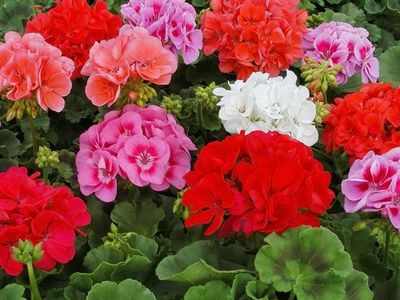
Pelargonium Pelargonium (Pelargonium) belongs to the geranium family. More than 250 species are known in nature. Homeland - South Africa. One of the most popular crops both outdoors and indoors. Pelargoniums do not have a pronounced dormant period. Plants can live for a long time with little or no water, as they have a semi-succulent stem. They do not tolerate dampness, especially in winter time. There are thousands of varieties of pelargoniums with variously colored flowers: white, orange, pink, red, raspberry, lilac, purple, violet, variegated. The stems are erect, creeping, the leaves are green and multi-colored, often emitting a pleasant aroma when touched.
The most widespread are three types of pelargoniums - zonal (R. zonale Ait.), Ivy-shaped pelargonium, or creeping (R. peltatum Ait.), and large-flowered pelargonium (R. grandiflorum Willd.). Less common is fragrant pelargonium (P. denticulatum,), which is grown for the sake of openwork foliage and a pleasant smell. Pelargonium zonal is known as "just geranium". It got its name from the Greek zona - belt "due to a darker stripe that runs along the sheet and repeats its shape. It appeared in Europe at the beginning of the 18th century. as a potted plant and gave rise to numerous hybrids. In 1889, the French gardener Lemoine developed the Meteor variety, which is now widely distributed. Stem erect, branched, 35-60 cm tall, densely pubescent, woody at the base with age. The leaves are light green, large, rounded with shallow recesses, sitting on long petioles, arranged in a spiral, sometimes there is a brown rim on the leaves. At a close distance, a pleasant smell is felt. The flowers are large, simple, fiery red, collected in umbrellas.
Ivy pelargonium is a highly decorative ampelous plant with thin hanging or climbing faceted shoots with fleshy dark green, shiny, rounded cut leaves. The flowers are very bright simple, semi-double and double, collected in umbrella inflorescences on strong peduncles. The color of the flowers is varied: red, pink, lilac, raspberry, white and orange, in different tones and shades.
Large-flowered pelargonium has rough, folded, serrated leaves and very beautiful, fairly large, single-color flowers with spotted petals. Modern varieties bloom not only on windows and balconies, but also in open ground all summer.
Pelargoniums propagate by cuttings at any time of the year. The cuttings root easily in the sand. For summer gardening, cuttings are usually taken from February to April. Cuttings are taken from strong, healthy mother plants, apical and lateral shoots. If reproduction requires a large number of cuttings, then it is advisable to grow mother plants in the soil of greenhouses, where they can be in one place for more than 10 years. If a small number of cuttings are required, then the mother plants are kept in pots, transplanted annually into new soil in February. Mother plants should not fatten, because cuttings from such plants take root poorly and often rot. Pelargoniums fatten from excess nitrogen, so they cannot be planted in oily soil. Winter care consists of moderate watering, loosening, cleaning plants from yellow leaves, adding earth to pots. Mother plants are kept in a greenhouse in winter at a temperature of 6-8°C. In February the temperature rises to 15-18°C. To get more cuttings, plants are not allowed to bloom, all flower buds are broken out at the very beginning of their development.
Cuttings 10 cm long with 3-4 internodes are cut with a sharp knife, the lower leaves are removed, and the cuts are dried, i.e. leave them to lie in a cold room for several hours until the cut is covered with a thin film, or treat the cut with dry crushed charcoal mixed with heteroauxin powder (1 tablet per 100 g of coal). Plant cuttings in boxes or on racks at a distance of 8 X 8 cm. ) and moisturize well. Landing is done to a depth of 2-3 cm. For rapid rooting, it is required: a bright place, a temperature of 12-15 °, rare abundant watering, it is impossible to spray the cuttings, and when watering, you should try not to wet the leaves. Before the formation of calus, the cuttings must be protected from direct sun rays and drops of film or paper. They take root in 12-15 days. If the cuttings are rarely planted and are in a bright place, they do not stretch, and after rooting they can be left in the same place for another two to three weeks. In April, they are planted in 9-11 cm pots or in plastic cups and placed in picking boxes of 15 plants. For planting, they take compost soil or make up a mixture of light turf, humus, peat soil and sand (4: 4: 2: 1). For the formation good bush in April, the tops of the stems are cut off, which are used for cuttings. Sometimes the plants stretch out, and the tops of the side branches have to be cut off a second time, thanks to which the bushes become branched and dense. Cuttings can be immediately in peat pots or in ordinary pots with earth. This greatly saves labor and cost. Before landing in the ground, pelargonium must be kept in sunny places and hardened in May by opening greenhouses for the day. In room conditions, pelargoniums are grown on sunny windows. In winter, it is better to keep them on bright cold windows (7-10 °). From hot air batteries central heating plants are isolated with a polyethylene curtain. They feel great in the summer on the southern, southwestern and southeastern balconies. It is better for amateur gardeners to cut pelargoniums before frosts at the end of September. In a two-liter pot, 7-10 cuttings are planted at once. In February-March, they are planted one by one in pots and at the same time the tops of the shoots are cut to form bushes. In the summer, pots are dug near garden houses.
Pelargonium is planted in the ground in early June. The distance when planting between plants is 25 cm. The flower beds look very elegant from the first day until the frost. This plant is very unpretentious, tolerates dryness well, but must be protected from stagnant water. Summer care consists of weeding, watering and loosening. In the autumn, before frosts, the plants are transplanted into pots, brought into greenhouses or planted in the soil of the greenhouse and used as mother liquors for several years. Pelargonium is indispensable as a pot culture for landscaping balconies, for planting in the ground and for cutting. It looks impressive in hanging baskets, pots on the walls of loggias, on window sills, it looks good as bright spots on lawns, near pools, at the entrance to a garden house.
Pelargonium
Pelargonium is loved by flower growers and is successfully grown as an indoor, balcony and even garden plant (moving to the garden for the summer). Some do not like pelargonium, considering it a rustic, rustic, grandmother's plant, but I think they just have not had time to appreciate all its beauty and variety of varieties. Although there are objective reasons for some people not to plant this plant in their home. The fact is that the plant is rich in essential oils, which give the pelargonium its characteristic smell, which can affect people in different ways. Some like it, others do not, it has a calming effect on some people, others cannot stand it, it depends on the characteristics of the body of different people. In addition, some types of geraniums are slightly poisonous and can cause contact dermatitis in some people.
The most common among flower growers are zonal pelargonium and ivy-leaved pelargonium.
 1. Pelargonium zonal - perennial plant. This is the most common group of pelargoniums, it includes more than 1000 varieties. It is characterized by a pattern on softly pubescent long-petiolate leaves of a darker shade, repeating the shape of the leaf. Zonal pelargoniums have large bright flowers collected in multi-flowered umbellate inflorescences. Flowers can have varying degrees of doubleness, and the color of the petals can have all sorts of shades, including two-tone with an eye in the center or a border around the edge. Different varieties of zonal pelargoniums have different height, they can be dwarf with a height of about 20 cm, medium-sized up to 40 cm or tall over 42 cm. different varieties also differs, zonal pelargoniums can be phlox-shaped, star-shaped, cactus-shaped, rose-shaped, bouquet.
1. Pelargonium zonal - perennial plant. This is the most common group of pelargoniums, it includes more than 1000 varieties. It is characterized by a pattern on softly pubescent long-petiolate leaves of a darker shade, repeating the shape of the leaf. Zonal pelargoniums have large bright flowers collected in multi-flowered umbellate inflorescences. Flowers can have varying degrees of doubleness, and the color of the petals can have all sorts of shades, including two-tone with an eye in the center or a border around the edge. Different varieties of zonal pelargoniums have different height, they can be dwarf with a height of about 20 cm, medium-sized up to 40 cm or tall over 42 cm. different varieties also differs, zonal pelargoniums can be phlox-shaped, star-shaped, cactus-shaped, rose-shaped, bouquet.
Zonal pelargoniums are grown as indoor, balcony and garden plants. They lend themselves perfectly to formation, thanks to which you can get both a neat bush and a small tree at your request. The life span of zonal pelargonium is more than 20 years.
Variegated pelargoniums also belong to the group of zonal pelargoniums. Their beauty is not mainly in the flowers, but in the interesting color of the leaves, which can have various combinations and shades of white, yellow, silver, bronze. Variegated varieties of zonal pelargonium are usually undersized, they are used both as indoor pot plants and as garden plants. In the garden, they are mainly used for making annual carpet compositions.
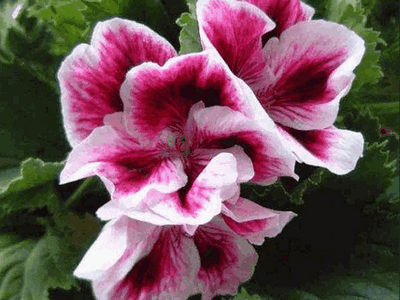 2. Large-flowered pelargonium is also very common and numerous. This pelargonium can also be found under other names, it is often called English or royal, as well as French and domestic. Plants of this group are distinguished by unusually beautiful flowers up to 8 cm in diameter and lush large inflorescences - bouquets. This group is characterized by greater tallness of plants. Large-flowered pelargoniums have rather thin stems, woody at the base, which in the first year stretch up to 40-80 cm, depending on the variety, and subsequently can reach 2-3 meters and need support. The leaves of large-flowered pelargoniums are rounded or maple-shaped, about 5-7 cm in diameter, covered with sparse hard pubescence, serrated or serrate at the edges, the color is bright green. Ancient varieties usually bloom only once a year, while modern varieties are able to bloom continuously for 9 months. Large-flowered pelargoniums are used mainly as houseplants, since they are not very suitable for growing in the garden. Their place is on sunny windows, loggias and bright halls.
2. Large-flowered pelargonium is also very common and numerous. This pelargonium can also be found under other names, it is often called English or royal, as well as French and domestic. Plants of this group are distinguished by unusually beautiful flowers up to 8 cm in diameter and lush large inflorescences - bouquets. This group is characterized by greater tallness of plants. Large-flowered pelargoniums have rather thin stems, woody at the base, which in the first year stretch up to 40-80 cm, depending on the variety, and subsequently can reach 2-3 meters and need support. The leaves of large-flowered pelargoniums are rounded or maple-shaped, about 5-7 cm in diameter, covered with sparse hard pubescence, serrated or serrate at the edges, the color is bright green. Ancient varieties usually bloom only once a year, while modern varieties are able to bloom continuously for 9 months. Large-flowered pelargoniums are used mainly as houseplants, since they are not very suitable for growing in the garden. Their place is on sunny windows, loggias and bright halls.
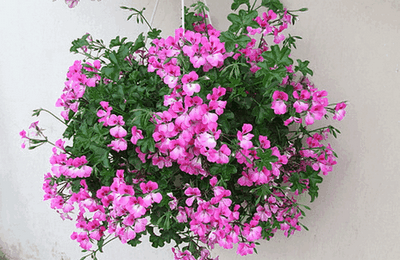 3. Ivy pelargonium (thyroid) - these are complex hybrids of thyroid and faceted pelargonium, they are ampelous plants with thin flexible highly branched stems. Ivy pelargoniums form an unusually beautiful cascade of bright inflorescences. Ivy pelargonium flowers are medium in size, they are collected in umbellate inflorescences of 8-15 pieces. Flowers may have varying degrees of doubleness and various colors. The leaves are fleshy, dense, with a wax coating, sometimes with a slight pubescence, green or with a concentric pattern, reminiscent of ivy leaves. Ivy pelargoniums are used both as indoor, and as a balcony, and as a garden plant. Their flowering can last all year round. From the ivy pelargonium, you can form a beautiful standard tree.
3. Ivy pelargonium (thyroid) - these are complex hybrids of thyroid and faceted pelargonium, they are ampelous plants with thin flexible highly branched stems. Ivy pelargoniums form an unusually beautiful cascade of bright inflorescences. Ivy pelargonium flowers are medium in size, they are collected in umbellate inflorescences of 8-15 pieces. Flowers may have varying degrees of doubleness and various colors. The leaves are fleshy, dense, with a wax coating, sometimes with a slight pubescence, green or with a concentric pattern, reminiscent of ivy leaves. Ivy pelargoniums are used both as indoor, and as a balcony, and as a garden plant. Their flowering can last all year round. From the ivy pelargonium, you can form a beautiful standard tree.
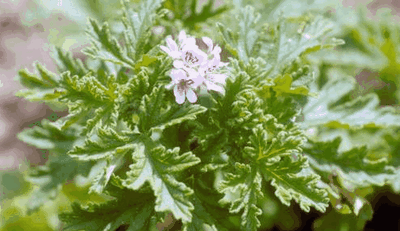 4. Fragrant (fragrant) pelargonium. This is a group of pelargoniums that have a pleasant aroma when touched on its parts. These pelargoniums are used mainly in industrial plantations in order to obtain geranium oil. The aroma of these plants can be lemon-apple, pink, verbena, pineapple. In countries with warm climates fragrant pelargoniums used in landscaping parks.
4. Fragrant (fragrant) pelargonium. This is a group of pelargoniums that have a pleasant aroma when touched on its parts. These pelargoniums are used mainly in industrial plantations in order to obtain geranium oil. The aroma of these plants can be lemon-apple, pink, verbena, pineapple. In countries with warm climates fragrant pelargoniums used in landscaping parks.
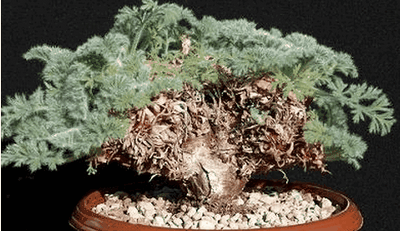 5. Succulent pelargoniums are still little known in our country. These pelargoniums have highly branched, beautifully curved stems, woody at the base, reminiscent of baobab miniatures or some fabulous creatures with their interesting intricate shapes. Succulent pelargoniums are used in interior decoration, in creating bonsai-style compositions, in rocky gardens. There are about 10 species of succulent pelargoniums, the most common are humpbacked pelargonium, cortus-leaved pelargonium, fleshy pelargonium, regular pelargonium, fluffy-leaved pelargonium, thick-stemmed pelargonium and angular pelargonium.
5. Succulent pelargoniums are still little known in our country. These pelargoniums have highly branched, beautifully curved stems, woody at the base, reminiscent of baobab miniatures or some fabulous creatures with their interesting intricate shapes. Succulent pelargoniums are used in interior decoration, in creating bonsai-style compositions, in rocky gardens. There are about 10 species of succulent pelargoniums, the most common are humpbacked pelargonium, cortus-leaved pelargonium, fleshy pelargonium, regular pelargonium, fluffy-leaved pelargonium, thick-stemmed pelargonium and angular pelargonium.
Doors "Profildoors" are made of modern materials on new technologies. Doors Profildors are not only very beautiful, they have excellent operational characteristics, easy to care for, environmentally friendly and safe.
__________________________________________________________
Pelargoniums are very photophilous, and easily tolerate even direct sunlight, so it is best to determine a place for them on the windowsill of the south window. Although, in the absence of such, your pelargonium will grow well on both the eastern and northern windows, except that it will stretch a little during the winter months.
Pelargonium loves Fresh air, the room where she grows, it is advisable to regularly ventilate, and for the summer it is better to arrange a summer vacation for her in the garden. At the same time, it is not advisable to transplant the plant into open ground, if you subsequently want to bring it back into the house, it is better to dig it into the ground along with the pot. Otherwise, your beauty, feeling the will, will begin to gain green mass, which will go to the detriment of flowering.
In winter, buds are laid for future flowering, the desired temperature for the plant at this time is about 11-13 degrees, watering the plant at this time should be very moderate as the earthen coma dries up.
Pelargoniums do not like waterlogging and tolerate dry air well. In summer, the plant is watered moderately after 2-3 days, spraying will be useful in summer only during a particularly hot period.
Sometimes the lower leaves on the plant may turn yellow and dry out, they should not be cut off, as the tissue exposed in this case may begin to rot. It is better to cut the leaves, leaving part of the petiole on the trunk. If you notice decay on the trunk, you must urgently cut it to a healthy tissue and sprinkle the wound with crushed coal.
The soil for pelargoniums should be light permeable with a neutral or slightly acidic reaction. The pot must be with drainage holes.
Pelargoniums are propagated by cuttings. Seed propagation is used mainly for breeding purposes. For cuttings use the tops of shoots with 3-5 leaves. Cuttings are carried out in February-March or in summer in July-August. The cut cuttings are slightly dried for 1-2 hours, then the ends are dipped in coal powder and planted in a container with soil. A container with cuttings is placed in a bright place without direct sunlight, watered very carefully or simply sprayed. Rooting time for cuttings is about 2-3 weeks. When the cuttings take root, they are seated in separate pots. Pots should be small, about 9 cm, so the plant will bloom faster. Cuttings rooted in summer bloom in April, rooted in February-March will bloom in mid-summer.
Plant transplantation is carried out in March. Young plants are transplanted annually, into fresh ground, while doing formative pruning, in order to subsequently obtain lush, profusely flowering plants. To do this, 2 to 5 buds are left on each shoot. Adult plants are transplanted as needed (if the pot becomes small).

